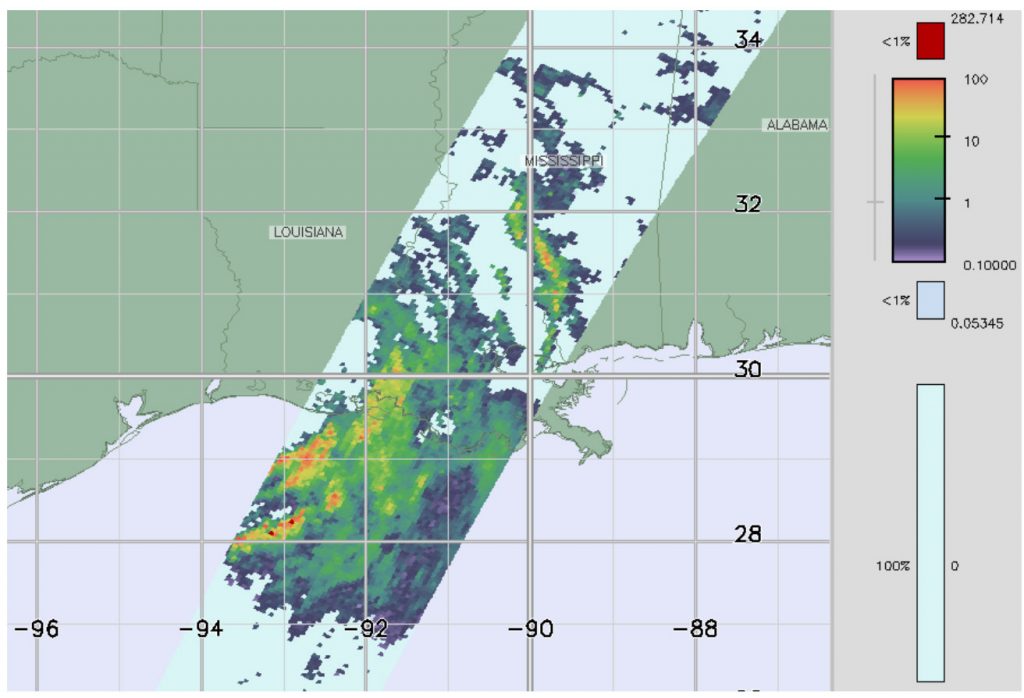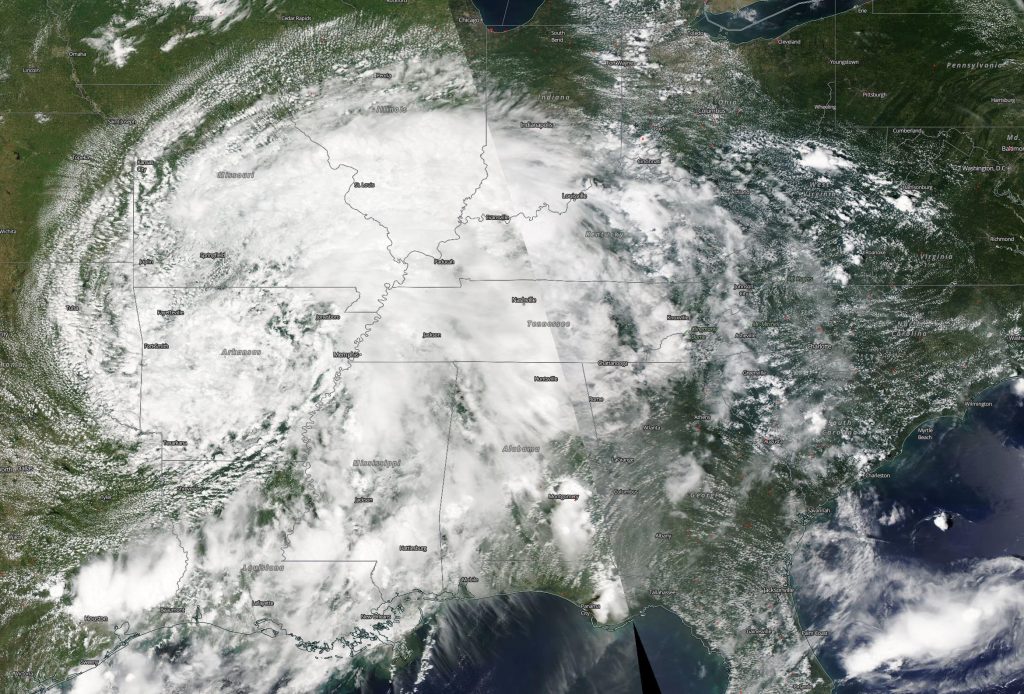July 16, 2019 – NASA Looks at Barry’s Rainfall Rates
After Barry made landfall as a Category 1 hurricane, NASA’s GPM core satellite analyzed the rate in which rain was falling throughout the storm. Now that Barry is a post-tropical cyclone moving through the mid-Mississippi Valley and toward the Ohio Valley, it is bringing some of that rainfall with it.

NASA Analyzes Barry’s Rain Rates
GPM core satellite passed over Barry and analyzed its rainfall rates several hours after it had made landfall on the coast of Louisiana. Instantaneous surface rain rates were derived from the Dual-polarization Radar onboard the GPM core satellite on July 14 at 02:42 UTC (July 13 at 10:42 p.m. EDT). The GPM data revealed heavy rain bands wrapping up around the eastern side of the storm’s center from the Gulf of Mexico and into central Louisiana and Mississippi. Rainfall rates in those areas were greater than 10 mm/hour (0.4 inches per hour). Some of the storm’s asymmetry was also revealed by the fact that the rain shield is much heavier and broader south of the center of circulation.
At the time of this image, the center of Barry was located about 35 miles southwest of Alexandria, Louisiana and had maximum sustained winds of 50 mph. The following day, July 14, Barry continued its northward trek into northwestern Louisiana and weakened to a tropical depression before it continued into Arkansas. Despite numerous power outages and localized flooding, there were no reports of fatalities or serious injuries due to Barry.
Barry’s History
Barry formed from an area of low pressure that originated over the Tennessee Valley from a thunderstorm complex, which then drifted southward through the Florida Panhandle, off of the coast and out over the northeastern Gulf of Mexico on July 10. There it provided a focus for showers and thunderstorms, which led to its gradual intensification. Despite the warm waters of the Gulf, the system was slow to strengthen due to inhibiting northerly wind shear. Nevertheless, it became Tropical Storm Barry on July 11 at 10:00 am CDT about 95 miles south-southeast of the mouth of the Mississippi River at which time it was drifting slowly westward.

Over the next day, Barry slowly intensified into a strong tropical storm as it continued to move west, but northerly wind shear and accompanying drier air caused Barry to remain rather asymmetrical with most of the heavier rain and thunderstorm activity located in the southern half of the storm. Fortunately, this precluded the storm from taking full advantage of the warm waters and quickly intensifying. It also meant that the heaviest rains stayed offshore. After drifting generally slowly westward to this point, Barry finally began to recurve to the northwest on Saturday, July 13 while gaining just enough intensity to become a hurricane before hitting the coast of Louisiana.
Barry became the first hurricane of the 2019 season just before making landfall on the south-central coast of Louisiana near Intracoastal City on Saturday, July 13. The storm came ashore around 1 p.m. CDT (18:00 UTC) with sustained winds reported at 75 mph by the National Hurricane Center, making Barry a minimal Category 1 hurricane. The biggest threats posed by Barry were heavy rains and flooding due to the storm’s slow movement, close proximity to land, and time spent organizing over the warm waters of the Gulf of Mexico.
As Barry moved further inland, it continued to recurve more towards the north and slowly increased its forward speed while weakening back to a tropical storm.
Watches and Warnings on Effect on July 16, 2019
As Post-tropical cyclone Barry moves northeastward, there are several watches and warnings in effect on July 16. Flash Flood Watches are in effect from the Ark-La-Tex eastward through the Lower and Middle Mississippi Valley. The Ark-La-Tex region consisting of Northwest Louisiana, Northeast Texas, and South Arkansas. Flash Flood Warnings are in effect for portions of southern Arkansas. Flood Warnings are in effect for portions of southern Louisiana, Arkansas, and Mississippi. Coastal Flood Advisories are in effect for portions of the Louisiana coast.
Where is Barry on July 16, 2019
At 5 a.m. (0900 UTC) on Tuesday, July 16, the center of Post-Tropical Cyclone Barry was located near latitude 37.8 degrees north and longitude 92.3 degrees west. That’s about 75 miles (120 km) northeast of Springfield, Missouri. The post-tropical cyclone is moving toward the northeast near 14 mph (22 kph) and this motion is expected to continue today with a gradual turn more easterly by tonight. The estimated minimum central pressure is 1011 millibars (29.86 inches). Maximum sustained winds are near 15 mph (30 kph) with higher gusts. Little change in strength is forecast during the next 48 hours
Expected Rainfall from Barry
The National Weather Service Weather Prediction Center in College Park, Maryland said, “Barry is expected to produce additional rain accumulations of 3 to 6 inches across portions of southern Arkansas, northern Mississippi and far southwestern Tennessee. Isolated maximum totals exceeding 10 inches are possible across southwest Arkansas. Rainfall accumulations of 1 to 3 inches, locally higher are expected across portions of the Ohio Valley today into tonight [July 16].
For updated forecasts, visit: www.nhc.noaa.gov
By Steve Lang / Rob Gutro
NASA’s Goddard Space Flight Center
